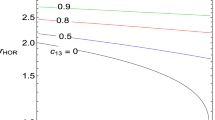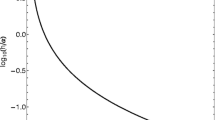Abstract
The orbital properties of stars moving on the (R, z) plane of a disk galaxy with a central rotating black hole are numerically investigated. For modeling the dynamical system, we use a pseudo-Newtonian potential that can replicate specific physical properties of a rotating distribution of matter, such as the position of the marginally bound orbit and the radius of the last stable orbit for the Kerr metric. Massive sets of starting conditions are classified for determining the dynamics of the test particle’s trajectories. Specifically, we manage not only to distinguish regular, chaotic, and collisional motion but also categorize all regular trajectories into regular families. The orbit taxonomy suggests that the angular momentum of the central black hole has a profound influence on the orbital properties of the galaxy. In particular, we find that stars having energies that correspond to motion relatively close to the black hole are highly affected by its rotation, while stars moving at large galactocentric distances are less influenced by the same parameter. In addition, it is numerically demonstrated that the appearance of certain resonant orbits is due to the rotation of the central black hole.










Similar content being viewed by others
References
Graham AW (2016) Galaxy bulges and their massive black holes: a review. Galactic Bulges, 263-313
Laha S, Reynolds CS, Reeves J et al (2021) Ionized outflows from active galactic nuclei as the essential elements of feedback. Nature Astron 5:13–24
Ferrarese L, Merritt DA (2000) Fundamental relation between supermassive black holes and their host galaxies. Astrophys J Lett 539(1):L9
Ciotti L, Ostriker JP (2007) Radiative feedback from massive black holes in elliptical galaxies: AGN flaring and central starburst fueled by recycled gas. Astrophys J Lett 665(2):1038
Cen R (2012) Physics of coevolution of galaxies and supermassive black holes. Astrophys J Lett 755(1):28
Storchi-Bergmann T, Schnorr-Müller A (2019) Observational constraints on the feeding of supermassive black holes. Nature Astron 3(1):48–61
Volonteri M, Sikora M, Lasota JP, Merloni A (2013) The evolution of active galactic nuclei and their spins. Astrophys J Lett 775(2):94
Reynolds CS (2021) Observational constraints on black hole spin. Annual Rev Astron Astrophys 59:117–154
Kerr RP (1963) Gravitational field of a spinning mass as an example of algebraically special metrics. Phys Rev Lett 11:237
Thorne KS, Misner CW, Wheeler JA (2000) Gravitation. Freeman, USA
Fiacconi D, Sijacki D, Pringle JE (2018) Galactic nuclei evolution with spinning black holes: method and implementation. Monthly Notices R Astron Soc 477(3):3807–3835
Griffin AJ, Lacey CG, Gonzalez-Perez V, Lagos CDP, Baugh CM, Fanidakis N (2019) The evolution of SMBH spin and AGN luminosities for \(z <6\) within a semi-analytic model of galaxy formation. Monthly Notices R Astron Soc 487(1):198–227
Bustamante S, Springel V (2019) Spin evolution and feedback of supermassive black holes in cosmological simulations. Monthly Notices R Astron Soc 490(3):4133–4153
Berentzen I, Preto M, Berczik P, Merritt D, Spurzem R (2009) Binary black hole merger in galactic nuclei. Astrophys J 695(1):455
Rantala A, Pihajoki P, Johansson PH, Naab T, Lahén N, Sawala T (2017) Post-Newtonian dynamical modeling of supermassive black holes in galactic-scale simulations. Astrophys J 840(1):53
Paczynsky B, Wiita PJ (1980) Thick accretion disks and supercritical luminosities. Astron Astrophys 88:23–31
Steklain AF, Letelier PS (2006) Newtonian and pseudo-Newtonian Hill problem. Phys Lett A 352(4):398–403
Dubeibe FL, Lora-Clavijo FD, González GA (2017) Pseudo-Newtonian planar circular restricted 3-body problem. Phys Lett A 381:563–567
Zotos EE, Dubeibe FL, Nagler J, Tejeda E (2019) Orbit classification in a pseudo-Newtonian Copenhagen problem with Schwarzschild-like primaries. MNRAS 487:2340–2353
Zotos EE, Dubeibe FL, González GA (2018) Orbit classification in an equal-mass non-spinning binary black hole pseudo-Newtonian system. MNRAS 477(4):5388–5405
Hawley JF, Krolik JH (2001) Global MHD simulation of the inner accretion disk in a pseudo-Newtonian potential. Astrophys J 548(1):348
Zotos EE, Dubeibe FL, Steklain AF, Saeed T (2020) Orbit classification in a disk galaxy model with a pseudo-Newtonian central black hole. Astron Astrophys 643:A33
Mukhopadhyay B, Misra R (2003) Pseudo-Newtonian potentials to describe the temporal effects on relativistic accretion disks around rotating black holes and neutron stars. Astrophys J 582(1):347
Ivanov RI, Prodanov EM (2005) Pseudo-Newtonian potential for charged particle in Kerr-Newman geometry. Phys Lett B 611(1–2):34–38
Ghosh S, Mukhopadhyay B (2007) Generalized pseudo-Newtonian potential for studying accretion disk dynamics in off-equatorial planes around rotating black holes: Description of a vector potential. Astrophys J 667(1):367
Artemova IV, Björnsson G, Novikov ID (1996) Modified Newtonian potentials for the description of relativistic effects in accretion disks around black holes. Astrophys J 461:565
Semerák O, Karas V (1999) Pseudo-Newtonian models of a rotating black hole field. Astron Astrophys 343:325–332
Mukhopadhyay B (2002) Description of pseudo-Newtonian potential for the relativistic accretion disks around Kerr black holes. Astrophys J 581(1):427
Steklain AF, Letelier PS (2009) Stability of orbits around a spinning body in a pseudo-Newtonian Hill problem. Phys Lett A 373(2):188–194
Rojas-Niño A, Martínez-Medina LA, Pichardo B, Valenzuela O (2015) Detecting triaxiality in the galactic dark matter halo through stellar kinematics ii. dependence on nature dark matter and gravity. Astrophys J 805(1):29
Martínez-Medina LA, Pichardo B, Moreno E, Peimbert A, Velazquez H (2016) On the Origin of High-altitude Open Clusters in the Milky Way. ApJ 817:L3
Miyamoto M, Nagai R (1975) Three-dimensional models for the distribution of mass in galaxies. Publ Astron Soc Japan 27:533
Skokos C (2001) Alignment indices: a new, simple method for determining the ordered or chaotic nature of orbits. J Phys A 34:10029
Carpintero DD, Aguilar LA (1998) Orbit classification in arbitrary 2D and 3D potentials. MNRAS 298:1
Novikov ID, Frolov VP (1989) Physics of black holes. Kluwer, Dordrecht
Binney J, Tremaine S (2008) Galactic dynamics. Princeton University Press, Princeton
Skokos C, Antonopoulos C, Bountis TC, Vrahatis MN (2004) Detecting order and chaos in Hamiltonian systems by the SALI method. J Phys A: Math Gen 37:6269
Zotos EE, Carpintero DD (2013) Orbit classification in the meridional plane of a disk galaxy model with a spherical nucleus. Celest Mech Dyn Astron 116:417
Press HP, Teukolsky SA, Vetterling WT, Flannery BP (1992) Numerical recipes in FORTRAN 77, 2nd edn. Cambridge University Press, Cambridge
Nagler J (2004) Crash test for the Copenhagen problem. Phys Rev E 69:066218
Nagler J (2005) Crash test for the restricted three-body problem. Phys Rev E 71:026227
Aguirre J, Vallego JC, Sanjuán MAF (2001) Wada basins and chaotic invariant sets in the Hénon-Heiles system. Phys Rev E 64:066208
Aguirre J, Viana RL, Sanjuán MAF (2009) Fractal structures in nonlinear dynamics. Rev Mod Phys 81:333
Acknowledgements
The present research work was funded by Princess Nourah bint Abdulrahman University Researchers Supporting Project number (PNURSP2022R106), Princess Nourah bint Abdulrahman University, Riyadh, Saudi Arabia.
Author information
Authors and Affiliations
Corresponding author
Ethics declarations
Compliance with Ethical Standards
The authors declare that they have no conflict of interest concerning the publication of this manuscript.
Additional information
Publisher's Note
Springer Nature remains neutral with regard to jurisdictional claims in published maps and institutional affiliations.
Rights and permissions
Springer Nature or its licensor holds exclusive rights to this article under a publishing agreement with the author(s) or other rightsholder(s); author self-archiving of the accepted manuscript version of this article is solely governed by the terms of such publishing agreement and applicable law.
About this article
Cite this article
Alrebdi, H.I., Dubeibe, F.L. & Zotos, E.E. Effects of the rotation of the central black hole in a disk galaxy model. Meccanica 57, 2253–2268 (2022). https://doi.org/10.1007/s11012-022-01577-7
Received:
Accepted:
Published:
Issue Date:
DOI: https://doi.org/10.1007/s11012-022-01577-7




